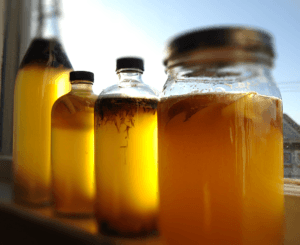I earn commissions if you shop through the links below at no additional cost to you.
Last Updated on February 29, 2024 by Jeremy
First off, what is fermentation? To define fermentation, it is “the chemical breakdown of a substance by bacteria, yeasts, or other microorganisms, typically involving effervescence and the giving off of heat.”
Knowing this, I’d like to break down the fermentation process, and give you an answer to one of the most popular questions that seems to be being asked more and more all the time: What are the best fermented foods to eat?
The Process – Wild Fermentation
When people meddle with nature, you get cooking!
The process of fermenting is to preserve and to make it more digestible and nutritious. Fermented foods have been drastically removed from Western diets. This type of food aids in stomach health and digestion, although it can be an acquired taste.
What are the Best Fermented Foods to Eat?
- Sauerkraut
- Kombucha
- Yogurt
- Beer
- Miso
- Cheese
- Pickles
- Brines
- Wines
- Vinegars
- Kimchi
- Sour Cream
- Sour Dough
- Ciders
These foods date back some thousands of years and fermented foods last months which makes you save money.
To check out some FAQ’s and How-To’s of this type of fermentation, check out this website: Fermented Vegetables How-Tos | Revolution Fermentation
Types of Fermentation
There are currently 3 types of fermentation known to humans. These include lactic acid fermentation, alcohol fermentation, and Acetic Acid Fermentation.
Of the first type, the foods, for example are pickles, Kimchi, yogurt and sour kraut.
The second type, you would have your beer or wine fermentation.
While the third type, you’d be making apple cider vinegar, condiments, and kombucha.
Recipes to Make at Home
Naturally, you’ll have some great fermentation products via the form of recipes.
Some examples include:
- Sauerkraut
- Kimchi
- Kefir
- Kombucha
- Pickles
- Beet Leaves
- Garlic
- Preserved Lemons
Of the above mentioned, here’s a Shared recipe from Preserved Lemons Recipe – NYT Cooking (nytimes.com)
INGREDIENTS
- 9 organic lemons
- Kosher salt
- 1heaping teaspoon black peppercorns
- 2 bay leaves
PREPARATION
- Scrub 3 to 5 organic lemons, enough to fit snugly in a medium jar with a tight-fitting lid (have 2 to 4 more ready on the side). Slice each lemon from the top to within ½ inch of the bottom, almost cutting them into quarters but leaving them attached at one end. Rub kosher salt over the cut surfaces, then reshape the fruit. Cover the bottom of the jar with more kosher salt. Fit all the cut lemons in, breaking them apart if necessary. Sprinkle salt on each layer.
- Press the lemons down to release their juices. Add to the jar the peppercorns and bay leaves, then squeeze the additional lemons into the jar until juice covers everything.
- Close the jar and let ripen at cool room temperature, shaking the jar every day for 3 to 4 weeks, or until the rinds are tender to the bite. Then store it in the refrigerator.
- To use, remove a piece of lemon and rinse it. (Add more fresh lemons to the brine as you use them up.) The minced rind is added at the very end of cooking or used raw; the pulp can be added to a simmering pot.
Equipment and Cost
This natures approach to food idea actually requires very little equipment, which saves on your cost.
For instance, Your main source for many of these recipes is distilled water. This process is taking regular water and boiling it down.
Next, you’ll need Organic produce. You can grow this at home instead of picking it up at the grocery store. However, if you must get it at the grocery store, make sure it is organic.
Third, You’ll need a starter of some sort. This is where the “natural” part becomes unnatural, however the process is natures way of its final production. Starter examples include: whey, bacterium, or salt.
Lastly, you’ll need glass wide-mouth jars which you can get at any hardware, home or garden center, or Amazon.
Final Thought
For Everything Nature and More, you have to remember we focus on more natural ways to approach, in this case, food. We want to show you how there are options when utilizing different foods and what we can make from them. If we all start off by getting rid of fast food restaurants as a daily routine, and start utilizing some fermented foods instead, we’d become better versions of ourselves and get our health back.
If you have any fermenting questions, such as the process of fermentation, or maybe even recipes to share, then do so by commentening below.
If you have another natural food suggestion, also let us know.
In the meantime, check out this article about Hemp: What’s Hemp Used For? 1 of Natures Plants better than Trees – Everything Nature and More
EARTH IS HEART!









Very good article on natural fermentation. I agree that fermented food has disappeared from our diets. I also agree that fermented foods are healthy for digestion and stomach health. I like most of the foods on your list, and my family occasionally eats them. We’ve tried to make sauerkraut, pickles, kimchi, and beet leaves. I would love a new sauerkraut recipe if you have one.
Thank you Carol,
Yes, fermentation is an easy process if you have the time, and the foods are delicious.
As for the sauerkraut recipe, the only one I remember tasting the best was similar to this one: How to Make Homemade Sauerkraut | Easy Sauerkraut Recipe | Nourished Kitchen.
I know of a personal friend that has her own kraut recipes, she has multiple flavors she makes…super good and healthy. Perhaps I’ll see if she will let me post one up in another article.